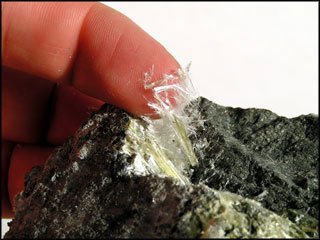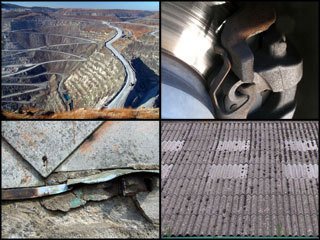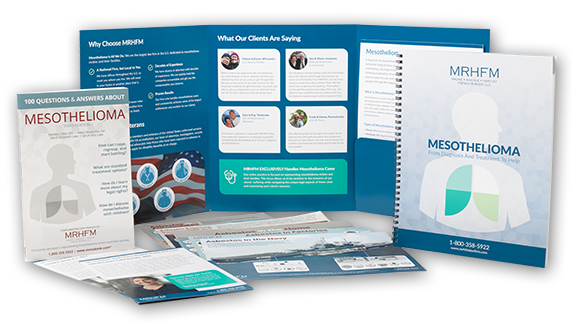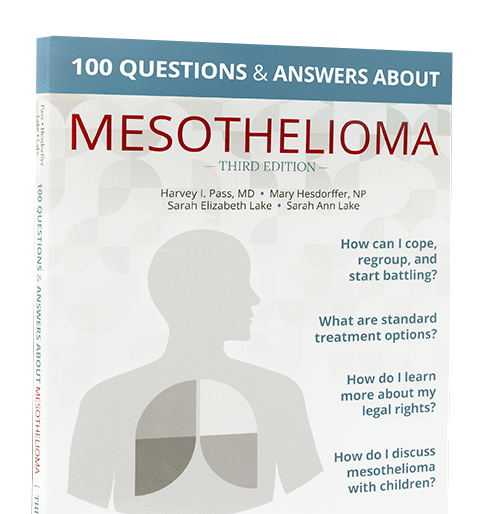What Causes Mesothelioma?
Asbestos is the cause of mesothelioma. Mesothelioma is caused by inhaling or ingesting asbestos fibers. The mineral asbestos gets its name from the Ancient Greeks. The Greeks recognized the fireproof qualities of asbestos, while recognizing the harmful effects on asbestos workers. The word asbestos means inextinguishable.
Asbestos is the generic name for six naturally occurring minerals. It is composed of silicon, oxygen, hydrogen, and several different metals. Asbestos can be divided into two basic groups, serpentine and amphibole, which differ in their physical characteristics. Serpentine asbestos develops in a layered form. Amphibole asbestos has a chain-like structure. The three most common types of fibers are chrysotile (white asbestos), amosite (brown or gray asbestos) and crocidolite (Riebeckite).
 Chrysotile asbestos is a white curly fiber and accounts for 90% of asbestos in products. Chrysotile is a member of the serpentine group and is a magnesium silicate. Amosite asbestos is made up of straight fibers containing iron and magnesium. Amosite is a member of the amphibole asbestos family. Crocidolite, a member of the amphibole asbestos family, takes the form of blue, straight fibers. Crocidolite is a sodium iron magnesium silicate. The other asbestos types, all in the amphibole group, are anthophyllite, tremolite, and actinolite. Anthophyllite ranges in color from white to gray to brown. It is associated with talc and other minerals. Anthophyllite is a magnesium iron silicate hydroxide. Tremolite is a calcium, magnesium, iron silicate and is white to grayish green. Tremolite can be found in various types of schists. Schists are metamorphic rocks usually named by the main mineral from which they are formed. Bitotite mica schist, hornblende schist, garnet mica schist, and talc schist are some examples. Actinolite has a chemical formula that is similar to tremolite, but actinolite contains more iron in relation to magnesium than does tremolite. Actinolite appears as dark green crystals or fibrous aggregates.
Chrysotile asbestos is a white curly fiber and accounts for 90% of asbestos in products. Chrysotile is a member of the serpentine group and is a magnesium silicate. Amosite asbestos is made up of straight fibers containing iron and magnesium. Amosite is a member of the amphibole asbestos family. Crocidolite, a member of the amphibole asbestos family, takes the form of blue, straight fibers. Crocidolite is a sodium iron magnesium silicate. The other asbestos types, all in the amphibole group, are anthophyllite, tremolite, and actinolite. Anthophyllite ranges in color from white to gray to brown. It is associated with talc and other minerals. Anthophyllite is a magnesium iron silicate hydroxide. Tremolite is a calcium, magnesium, iron silicate and is white to grayish green. Tremolite can be found in various types of schists. Schists are metamorphic rocks usually named by the main mineral from which they are formed. Bitotite mica schist, hornblende schist, garnet mica schist, and talc schist are some examples. Actinolite has a chemical formula that is similar to tremolite, but actinolite contains more iron in relation to magnesium than does tremolite. Actinolite appears as dark green crystals or fibrous aggregates.
The type of asbestos most people commonly recognize is generally made up of fiber bundles which easily separate into long, thick fibers. It was this property that first was recognized and used in ancient times for everlasting lamp wicks. In A.D. 77, Pliny the Elder published the first encyclopedia, Natural History. Pliny wrote, "Asbestos looks like alum and is completely fire-proof; it also resists all magic potions, especially those concocted by the Magi." Both Pliny and the ancient Greek geographer Strabo observed the "sickness of the lungs" in the slaves that wove asbestos into cloth.
Asbestos references can be found in texts from many different cultures throughout recorded history. Asbestos was used in very limited ways for many hundreds of years with its popularity increasing during the Industrial Revolution beginning in the late-1800's. Asbestos then began to be used as insulation for steam pipes, turbines, boilers, kilns, ovens, and other high-temperature products.
It was not until the early 1900's that knowledge regarding the dangerous propensities of asbestos began to resurface. An English physician performing a post-mortem on a man who worked with asbestos discovered asbestos fibers in the mans lungs. During the course of the next two decades, physicians noted that asbestos workers had uncommonly high levels of illness and disease. In the mid-1920's, an English doctor made what many believe was the first diagnosis of asbestosis. Soon thereafter, an English study showed that 25% of asbestos workers had signs of lung disease. England then began passing laws designed to protect English workers.
 Sadly, in the United States, asbestos use increased dramatically as other properties of asbestos were recognized. For example, asbestos was used as a filler in many plastics and adhesives (glues). Asbestos was used in paper production in order to obtain a higher grade of paper with a lower grade of pulp. Immediately before and after World War II, brakes, clutches, building plasters, cements, shingles, insulation, drywall joint compounds and textured paints commonly contained asbestos. Almost any building material over 30 years of age may contain or be attached to some type of asbestos containing product.
Sadly, in the United States, asbestos use increased dramatically as other properties of asbestos were recognized. For example, asbestos was used as a filler in many plastics and adhesives (glues). Asbestos was used in paper production in order to obtain a higher grade of paper with a lower grade of pulp. Immediately before and after World War II, brakes, clutches, building plasters, cements, shingles, insulation, drywall joint compounds and textured paints commonly contained asbestos. Almost any building material over 30 years of age may contain or be attached to some type of asbestos containing product.
Because of factors including the increasing human life span, better medical diagnostics and the myriad of products that have contained (or still do) contain asbestos, diagnoses of asbestos diseases are expected to increase for decades to come.
The books Outrageous Misconduct: The Asbestos Industry on Trial, written by Paul Brodeur, Pantheon Books, New York, New York, 1985, and Asbestos: Medical and Legal Aspects, 4th Edition, written by Barry I. Castleman, Aspen Law and Business, Engelwood Cliffs, New Jersey, 1996 and other sources of information show that asbestos companies had extensive knowledge that the use of asbestos in their products and by their employees would cause serious health issues for individuals in the future. The following are just a small sample of events that occurred that provided companies with knowledge that asbestos was dangerous:
- 1918: Frederick Hoffman, a medical statistician for the Prudential Life Insurance Company, reported in a United States Department of Labor Bulletin that American life insurance companies generally deny coverage to asbestos workers because of the "assumed health-injurious conditions of the industry."
- 1922: Louis Dublin, a statistician for the Metropolitan Life Insurance Company, writes that asbestos workers are at risk of injury to the lungs.
- 1930: One major asbestos company, Johns-Manville, produces a report, for internal company use only, detailing the fatalities and medical injuries of asbestos workers.
- 1932: A letter from the United States Bureau of Mines to asbestos manufacturer Eagle-Picher states, "It is now known that asbestos dust is one of the most dangerous dusts to which man is exposed."
- 1933: Metropolitan Life Insurance Company doctors find that 29% of the workers at one Johns-Manville plant are suffering from asbestosis. Johns-Manville settles lawsuits by 11 employees on the condition that the lawyer for the employees agrees that he will not bring any new actions against Johns-Manville.
- 1934: Officials at Johns-Manville and Raybestos Manhattan, rewrite an article about the diseases of asbestos workers written by a Metropolitan Life Insurance Company doctor to minimize the danger of asbestos dust.
- 1935: Johns-Manville and Raybestos Manhattan instruct the editor of Asbestos Magazine to publish nothing about asbestosis.
- 1936: A group of asbestos companies agree to sponsor research on the health effects of asbestos dust, but require that the companies have complete control over the disclosure of the results.
- 1937: Roy Bonsib, Chief Safety Inspector for the Standard Oil Company of New Jersey, documents illnesses such as asbestosis and analyzes the dust-creating potential of installing and removing asbestos insulation.
- 1937-38: The Industrial Hygiene Digest at the Industrial Hygiene Foundation includes 2 articles about industrial types of cancer by workers working with asbestos.
- 1942: An Owens Corning corporate memorandum refers to "medical literature on asbestosis . . . [and] scores of publications in which the lung and skin hazards of asbestos are discussed."
- 1942-43: The president of Johns-Manville says that the managers of another company were "a bunch of fools for notifying employees who had asbestosis." When one of the people in attendance ask, "Do you mean to tell me you would let them work until they drop dead?" According to deposition testimony, the response was, "Yes. We save a lot of money that way."
- 1944: Metropolitan Life Insurance Company finds 42 cases of asbestosis among 195 asbestos miners.
- 1944: The Journal of the Medical Association reports that asbestos is one of the "agents known or suspected to cause occupational cancer."
- 1948: The American Petroleum Institutes Medical Advisory Committee, whose members include oil giants, received a summary of a paper in which the chief pathologist for E.I. DuPont De Nemours & Co. suggested that the industry "aim at the complete elimination of the exposure" to asbestos.
- 1951: Asbestos companies remove all references to cancer before allowing publication of research they sponsor concerning exposure to asbestos.
- 1953: National Gypsums safety director wrote to the Indiana Division of Industrial Hygiene, recommending that acoustic plaster mixers wear respirators "because of the asbestos used on the product." Another company official notes that the letter was "full of dynamite," and urges that the letter be retrieved before reaching its destination. A memo from those files notes that the company "succeeded in stopping" the letter which "will be modified."
- 1964: Dr. Irving Selikoff publishes a study in the Journal of the American Medical Association, proving that people who work with asbestos containing materials have an abnormal incidence of asbestosis, lung cancer, and mesothelioma.
- 1989 and 1991: In 1989, the United States Environmental Protection Agency bans asbestos and most of its uses, but, in 1991, asbestos companies win a federal lawsuit which overturns the EPAs asbestos ban.
- 1999: The Florida Supreme Court rules that Owens Corning willfully withheld information about the dangers of working with the company's asbestos products. The Florida Supreme Court describes it as a "blatant disregard for human safety involving large numbers of people put at life-threatening risks."
As stated, the above actions by these companies are just a small sample of the many actions by companies using asbestos which did so in disregard of the safety of their employees and other innocent victims. Companies, who so frivolously ignored the health of the public and their own employees, are the targets of our litigation.





